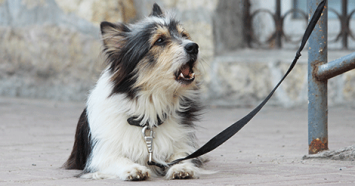
Asthma vs Allergic Bronchitis
The difference between asthma and allergic bronchitis can be a bit confusing. Asthma is an inflammatory disease of the lungs and airways which can cause sudden (acute) episodes of increased airway mucus, airway constriction or narrowing, and trouble breathing. Wheezing, coughing, breathing with the mouth open, and an appearance of struggling to breathe are common symptoms. Cats and humans experience similar forms of asthma.
Dogs do not typically develop the sudden episodes of airway constriction with inflammatory lung disease, so technically they don’t suffer from asthma. Asthma-like symptoms seen in dogs, such as coughing and wheezing, are more often a disease called allergic bronchitis. Allergic bronchitis is a chronic, or long-term, inflammatory airway and lung disease. The way the disease affects the airways is similar to asthma, such as mucus production and airway narrowing, but it causes more low-grade, constant or chronic symptoms, rather than a potentially life-threatening situation in which a pet is unable to get air into his or her lungs.
Cats can suffer from either disorder. To make things even more confusing, feline asthma is also known as feline allergic bronchitis, because the long-term aspect of allergic bronchitis is often present with feline asthma. In other words, long-term, consistent coughing and wheezing in a cat could be seen with either feline asthma or feline allergic bronchitis. The major difference is that with asthma, the cat will also suffer from potentially life-threatening ‘asthma attacks’ in which he or she struggles to breathe.
Causes of Asthma in Dogs and Cats
Both asthma and allergic bronchitis are thought to be caused by an allergy to something the pet breathes or inhales. They develop an allergic reaction to this allergen, leading to airway inflammation, mucus production, and airway narrowing. Dust, cigarette smoke, mold, pollen, cat litter dust, perfumes, and even dust mites are common inhaled allergens. These can cause the pet to cough and wheeze when they are exposed or breathe it in, or trigger an asthma attack and cause the more severe symptoms of struggling to breathe and breathing with the mouth open.
It is important to understand that open-mouth breathing looks a little different than panting. Panting, in which the pet acts otherwise normal but breathes with his or her mouth open wide, can have a variety of causes, such as being hot or excited. Open-mouth breathing, on the other hand, gives the appearance that the pet is in distress, his or her belly will move in and out in an effort to move air into the lungs, and the pet may not want to move around much, if at all. Cats rarely ‘pant,’ so if you have any doubts, call your vet, because open-mouth breathing is often an emergency situation.
Asthma Diagnosis
Diagnosing asthma and allergic bronchitis can sometimes be difficult. If the symptoms aren’t severe or don’t occur frequently, it may not be easy for the veterinarian to discover the problem. X-rays and labwork may be needed to help determine the cause of the symptoms, but sometimes these don’t show obvious disease changes either. Fluid examination from within the airways can be performed to help diagnose the condition, but it can be expensive and may not provide results that are specific for asthma or allergic bronchitis. Sometimes response to treatment is an unofficial way for diagnosis. If the pet improves on medications, he or she could be tentatively or unofficially diagnosed with asthma or allergic bronchitis. The important thing to recognize is that getting an official diagnosis can take time, and the veterinarian will often need many tests to piece together enough information to diagnose and treat your pet properly.
Asthma Treatment
Avoiding inhaled allergens is one way to help prevent symptoms or attacks. This can include changing to a less dusty litter, not spraying perfumes around the pet, and not smoking near the pet. Antihistamines are a medication that may help with certain types of allergens like pollen. Your veterinarian will help you determine if they will help and what kind to use. Other types of medications used for asthma or allergic bronchitis are steroids or immunosuppressant drugs- pill form, injections, or an inhaler or puffer. These help decrease the inflammation in the lungs and airways. An additional medication that may be prescribed is a bronchodilator, which helps open up the airways so your pet can breathe better. This type of medication also comes as a pill, injection, or inhaler. When inhalers are used in pets, they are usually given with an attachment that looks like a mask with a connected chamber. Most pets don’t breathe in or hold their breath on command, so the mask and chamber is helpful to get the medication down into the lungs. Your veterinarian can show you how to use the inhaler.
Be sure to talk to your veterinarian if you have concerns about giving any prescribed medications. Follow up with the vet frequently to ensure the medications are working and that your pet has the best quality of life possible. Always call if you suspect your pet is having an asthma attack or is struggling to breathe. Asthma and allergic bronchitis are life-long diseases and may require a bit more care and watchfulness to keep them happy and healthy.